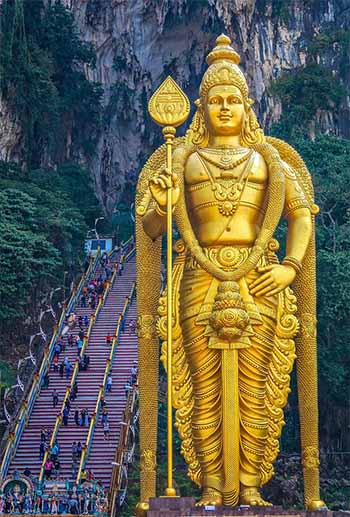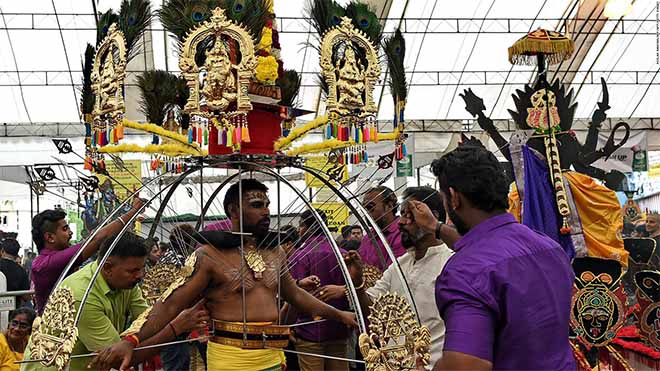Thaipusam festival
Pain As Offering For Lord Murugan

The Thaipusam festival is one of the most amazing rituals of Hinduism. Young devotees who have taken an oath puncture their cheeks and tongue, encrust themselves with voluminous hooks under the skin, stick spikes in their bodies and dance in a trance in the streets. And in a very mysterious way, sacred ashes affixed to their bodies prevent the blood of penitents from flowing.
Suffering as an offering to the god Murugan

In the tenth month of the Tamil lunar calendar, when the star Pusam shines in the full moon sky, Hindu believers celebrate their greatest holiday, whose origins date back over two millennia. Thaipusam glorifies the son of the Hindu gods Shiva and Parvathi. Their son, the six-headed Lord Murugan (Kartikeya), is the one who makes the vows. Any devotee directing his prayers to Murugan and requesting his favors must take the oath to offer him his pain, as well as honey, milk and flowers.
At night, believers gather in the courtyard of the Sri Srinivasa Peruma temple in the Indian quarter of Singapore, where the celebration is in full swing. The penitents prepare in family for their procession intended to attract the graces of Murugan.
The holy men and the trance of penitents

Fakirs and yogis prepare penitents: dozens of small hooks are embedded in the skin of their back and chest. Courage, endurance and insensitivity are the qualities required. Eyes are turned inward, eyes almost closed. For six weeks, the young Hindu undergoes fasting and intense preparation in order to keep his promise to his god. Oranges and lemons are then hung on the hooks attached to his skin. This stage is followed by the perforation of the cheeks, previously rubbed by the religious with consecrated ash. The music sounds, the heat is intense, drums and flutes rock the penitents until their eyes roll up and a spade as thick as a finger punctures their two cheeks. Very mysteriously, this treatment does not generate any drop of blood. The fakir then pierces the tongue of the devotee with a small pin, so that the two metal elements cross. Blood does not flow. The young devotee then opens his eyes and corrects the position of the stems on his face and his tongue. He seems to be in no pain. Assistants pour water into his mouth which will remain open overnight.
Peacock feathers and flowers for ornament
The cavadee is the aluminum arch 3 meters high, anchored in the hips and torso of the penitent and decorated with peacock feathers, flowers and pious images. Such structures weigh up to 60 kilos. Some even hang wooden carts on hooks planted in the flesh of their backs, then set off for the other temple. They seem to be numb, joy lights up their faces, and some carriers of cavadee engage in a frantic dance, barefoot on the asphalt. Family members keep pouring water into open mouths, pierced by crossed pins. At the entrance to the Sri Thendayythapani temple, assistants smash coconuts on the ground as an offering to the god. Then the penitents are released from the painful weight, which they nevertheless seem to have not felt. The fakirs then intervene again to remove with the appropriate gestures the pikes from the tongue and the cheeks of the believers. They then rub the holes with ash. No scar remains. Exhausted by this long ceremony, the penitents nevertheless experienced it as an immense source of joy and not of suffering.









































































































































































































































































































































